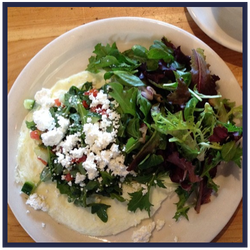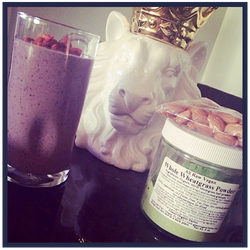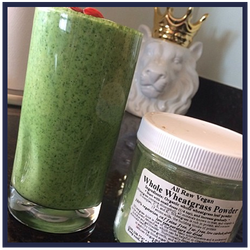Breakfast Fast and Easy.

Egg White Pancake: Now this would be a great option for breakfast, lunch and dinner.
Cooked Egg White
Green Onion
Any kind of greens (Spinach / Arugula / Kale)
Feta Cheese
Salt / Pepper
Drizzle of Olive Oil
Cooked Egg White
Green Onion
Any kind of greens (Spinach / Arugula / Kale)
Feta Cheese
Salt / Pepper
Drizzle of Olive Oil

For me smoothies have become part of my morning routine. Loaded with tons of nutrients, protein, and raw food, they provide energy throughout the morning. You can use any kind of yogurt see the benefits of all different options below the recipe:
SMOOTHIE RECIPE #1:
SMOOTHIE RECIPE #1:
- Yogurt of any kind (I used Greek here)
- Blackberries, Blueberries, Raspberries
- Almond Milk
- Handful of Almonds
- Chia Seeds
- Whole Wheatgrass Powder (Found at local farmers markets / Whole Foods)
- Goji Berries

SMOOTHIE RECIPE #2:
Mix until smooth (I use the Ninja blender) top off with Goji Berries for powerful antioxidants.
- Yogurt of any kind (I used Greek here)
- Kale
- Spinach
- Almond Milk
- Chia Seeds
- Whole Wheatgrass Powder (Found at local farmers markets / Whole Foods)
- Goji Berries
Mix until smooth (I use the Ninja blender) top off with Goji Berries for powerful antioxidants.
THE DIFFERENCE BETWEEN YOGURTS:
GREEK
Greek yogurt is super hot, mainly because it packs about twice as much protein as traditional yogurt. That’s because Greek yogurt is strained through a filter to remove the whey (liquid), giving it a thicker consistency and more protein per bite.
A single serving container of non-fat (0%) organic Greek yogurt like Oikos contains 80 calories, 0 grams of fat, 6 grams of carb, 15 grams protein, and 20 percent of the daily value for calcium. The only ingredients are pasteurized organic nonfat milk and live cultures (bacteria).
COCONUT
Coconut yogurt starts with coconut milk, which is pressed from the delicious white meat of the coconut with water added. The milk captures some of the good coconut fat, which has been shown in some recent research to help lower bad cholesterol and reduce belly fat. It also contains antioxidants similar to those in berries, grapes, and dark chocolate.
Like the other plant-based yogurts, when you read the ingredient list on a container of plain coconut milk yogurt you’ll likely see some added sugar and ingredients beyond the milk and live cultures. One single serve container of plain So Delicious contains 80 calories, 4.5 grams of fat (again that’s good-for-you fat), 12 grams of carb (3 as fiber), 0 grams of protein, and 20 percent of the daily value for calcium. The ingredients are: organic coconut milk, organic evaporated cane juice, pectin, chicory root extract (to add inulin, a natural substance that helps boost mineral absorption and support good bacteria), tapioca dextrose, magnesium phosphate, tricalcium phosphate, organic rice starch, locust bean gum, live cultures, carrageenan (a gelling agent from seaweed), dipotassium phosphate, and vitamin B12.
ALMOND
Almond milk yogurt starts with almond milk, which is made from whole ground almonds and water. While it’s delicious it’s also nutritious because almond milk retains the important nutrients naturally found in almonds, including antioxidants, heart healthy fat, fiber, vitamin E, and minerals like magnesium. Like soy yogurt, it’s also difficult to find an unsweetened version, and you’ll generally see thickeners in the ingredient list.
A single serve container of Amande’s peach almond milk yogurt (they don’t list ingredients on their web site and I couldn’t find plain at my local market) contains 150 calories, 6 grams of fat (again, the good, heart healthy kind from almonds), 22 grams of carb (2 as fiber), 3 grams of protein and 30 percent of the daily value for calcium. The ingredients are: almond milk, fruit juice concentrate, peaches, rice starch (thickener), locust bean gum (a thickener that comes from the seeds of the carob tree), pectin (a gelling agent that comes from plants), tapioca (thickener), natural flavor, tricalcium phosphate (a vegan source of calcium), annatto extract (a natural color from the seeds of the achiote tree), and active cultures.
Coconut
SOY
Soy yogurt starts with soy milk. Aside from being dairy free for those looking to eat less animal protein, soy yogurt may offer some unique benefits. A study published in the Journal of Food Biochemistry looked at how different kinds of yogurt helped control diabetes. They found that soy yogurt was particularly effective at blocking enzymes that impact carbohydrate digestion, which results in a slower, steadier rise in blood sugar after a meal. And a recent animal study found that rats fed soy yogurt had healthier livers and lower cholesterol levels. The downside is it’s difficult to find an unsweetened soy yogurt, and because they tend to be thinner in texture thickeners are often added.
A single serve contain of organic plain soy yogurt like Whole Soy & Co contains 190 calories, 6 grams of fat (although good fat, because it’s from the whole soybeans), 25 grams of carb (2 as fiber), 10 grams of protein, 45 percent of the daily value for calcium. The ingredients are: pasteurized organic soymilk, organic evaporated cane juice, organic cornstarch, tricalcium phosphate (a vegan source of calcium), organic natural flavor, and live active cultures.
SKYR
This Icelandic yogurt is becoming the new Greek. Technically a soft cheese, skyr includes the same basic ingredients: skim milk and live active cultures. It’s made using a centuries-old straining process that removes the liquid, which makes it very thick (seriously, stick a spoon in it and turn it upside down—it won’t fall out). Because of the removal of fluid, one cup of skyr requires three to four times the amount of milk needed to make a cup of traditional yogurt.
A single serve container of plain, nonfat skyr like Siggi’s provides 80 calories, 0 grams of fat, 5 grams of carb, 15 grams of protein and 17 perent of the daily value for calcium. The ingredients are pasteurized skim milk, live active cultures, and vegetable rennet (to help coagulation).
GREEK
Greek yogurt is super hot, mainly because it packs about twice as much protein as traditional yogurt. That’s because Greek yogurt is strained through a filter to remove the whey (liquid), giving it a thicker consistency and more protein per bite.
A single serving container of non-fat (0%) organic Greek yogurt like Oikos contains 80 calories, 0 grams of fat, 6 grams of carb, 15 grams protein, and 20 percent of the daily value for calcium. The only ingredients are pasteurized organic nonfat milk and live cultures (bacteria).
COCONUT
Coconut yogurt starts with coconut milk, which is pressed from the delicious white meat of the coconut with water added. The milk captures some of the good coconut fat, which has been shown in some recent research to help lower bad cholesterol and reduce belly fat. It also contains antioxidants similar to those in berries, grapes, and dark chocolate.
Like the other plant-based yogurts, when you read the ingredient list on a container of plain coconut milk yogurt you’ll likely see some added sugar and ingredients beyond the milk and live cultures. One single serve container of plain So Delicious contains 80 calories, 4.5 grams of fat (again that’s good-for-you fat), 12 grams of carb (3 as fiber), 0 grams of protein, and 20 percent of the daily value for calcium. The ingredients are: organic coconut milk, organic evaporated cane juice, pectin, chicory root extract (to add inulin, a natural substance that helps boost mineral absorption and support good bacteria), tapioca dextrose, magnesium phosphate, tricalcium phosphate, organic rice starch, locust bean gum, live cultures, carrageenan (a gelling agent from seaweed), dipotassium phosphate, and vitamin B12.
ALMOND
Almond milk yogurt starts with almond milk, which is made from whole ground almonds and water. While it’s delicious it’s also nutritious because almond milk retains the important nutrients naturally found in almonds, including antioxidants, heart healthy fat, fiber, vitamin E, and minerals like magnesium. Like soy yogurt, it’s also difficult to find an unsweetened version, and you’ll generally see thickeners in the ingredient list.
A single serve container of Amande’s peach almond milk yogurt (they don’t list ingredients on their web site and I couldn’t find plain at my local market) contains 150 calories, 6 grams of fat (again, the good, heart healthy kind from almonds), 22 grams of carb (2 as fiber), 3 grams of protein and 30 percent of the daily value for calcium. The ingredients are: almond milk, fruit juice concentrate, peaches, rice starch (thickener), locust bean gum (a thickener that comes from the seeds of the carob tree), pectin (a gelling agent that comes from plants), tapioca (thickener), natural flavor, tricalcium phosphate (a vegan source of calcium), annatto extract (a natural color from the seeds of the achiote tree), and active cultures.
Coconut
SOY
Soy yogurt starts with soy milk. Aside from being dairy free for those looking to eat less animal protein, soy yogurt may offer some unique benefits. A study published in the Journal of Food Biochemistry looked at how different kinds of yogurt helped control diabetes. They found that soy yogurt was particularly effective at blocking enzymes that impact carbohydrate digestion, which results in a slower, steadier rise in blood sugar after a meal. And a recent animal study found that rats fed soy yogurt had healthier livers and lower cholesterol levels. The downside is it’s difficult to find an unsweetened soy yogurt, and because they tend to be thinner in texture thickeners are often added.
A single serve contain of organic plain soy yogurt like Whole Soy & Co contains 190 calories, 6 grams of fat (although good fat, because it’s from the whole soybeans), 25 grams of carb (2 as fiber), 10 grams of protein, 45 percent of the daily value for calcium. The ingredients are: pasteurized organic soymilk, organic evaporated cane juice, organic cornstarch, tricalcium phosphate (a vegan source of calcium), organic natural flavor, and live active cultures.
SKYR
This Icelandic yogurt is becoming the new Greek. Technically a soft cheese, skyr includes the same basic ingredients: skim milk and live active cultures. It’s made using a centuries-old straining process that removes the liquid, which makes it very thick (seriously, stick a spoon in it and turn it upside down—it won’t fall out). Because of the removal of fluid, one cup of skyr requires three to four times the amount of milk needed to make a cup of traditional yogurt.
A single serve container of plain, nonfat skyr like Siggi’s provides 80 calories, 0 grams of fat, 5 grams of carb, 15 grams of protein and 17 perent of the daily value for calcium. The ingredients are pasteurized skim milk, live active cultures, and vegetable rennet (to help coagulation).

